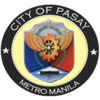Pasay
| City of Pasay Lungsod ng Pasay |
|||
|---|---|---|---|
| — Highly-urbanized City — | |||
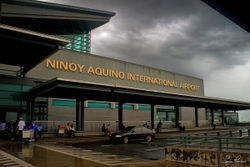 |
|||
|
|||
| Motto: The Gateway to the Philippines | |||
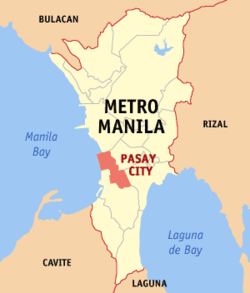 |
|||
| Country | |||
| Region | National Capital Region | ||
| Province | none | ||
| Districts | Lone District of Pasay City | ||
| Barangays | 201 | ||
| Incorporated (town) | December 2, 1863 | ||
| Incorporated (city) | June 21, 1947 | ||
| Government | |||
| - Mayor | Antonino G. Calixto (Liberal) | ||
| - Vice Mayor | Marlon A. Pesebre (PMP) | ||
| - Sangguniang Panlungsod |
Councilors
|
||
| Area | |||
| - Total | 19 km2 (7.3 sq mi) | ||
| Population (2007)[1] | |||
| - Total | 403,064 | ||
| - Density | 21,213/km2 (54,941.4/sq mi) | ||
| Time zone | PST (UTC+8) | ||
| ZIP code | 1300-1309 | ||
| Area code(s) | 2 | ||
| Website | Official Website of Pasay City | ||
The City of Pasay (Filipino: Lungsod ng Pasay) is one of the cities and municipalities that make up Metro Manila in the Philippines. It is bordered on the north by the country's capital, Manila, to the northeast by Makati City, to the east by Taguig City, and Parañaque City to the south.
Pasay City was one of the original four cities of Metro Manila. Due to its proximity to Manila, it quickly became an urban town during the American Period.
Contents |
Location

In terms of area, Pasay City is the third smallest political subdivision in the National Capital Region. It is adjacent to the City of Manila and is bounded to the south by Parañaque, to the northeast by Makati and Taguig and to the west by Manila Bay. The city is located at latitude 14° 32' and longitude 121° 00'.
The City has a total land area of 18.50 square kilometers of which 5.5050 square kilometer is the City proper, 9.5 square kilometers is being occupied by the Civil Aeronautics Administration (CAA) complex, which include the Ninoy Aquino International Airport (NAIA) and the Villamor Air Base and the rest of the reclamation area with 4.00 square kilometers. Thus, among the local government in the region, Pasay has the greater area devoted to utilities covering 51.35% of its total land area or 9.50 square kilometers. The City is known for its entertainment - business-restaurants, coffee shops, and clubs, particularly those located along Roxas Boulevard, facing Manila Bay. A large part of Metro Manila's "tourist belt" is located in the City. Pasay is composed of seven (7) districts, divided into twenty (20) Zones, with a total of 201 Barangays. Zone 19, Covering Barangays 178 and 191, is the largest among the zones with an area of 5.10 square kilometers. Zone 1, on the other hand, is the smallest covering Barangays 1 to 3 and 14 to 17 with an area of 100,000 square meters (0.1 km².).
Most of the attractions in the city are on the CCP (Cultural Center of the Philippines) Complex, on which the massive main CCP building, Philippine International Convention Center (PICC), Tanghalang Francisco Balagtas (formerly Folk Arts Theater), Manila Film Center, Coconut Palace, Product Design and Development Center of the Philippines (PDDCP), Philippine Trade Training Center (PTTC), World Trade Center-Metro Manila (WTCMM), Cuneta Astrodome, and theme parks such as Star City, Nayong Pilipino, and Boom na Boom are all located. Terminal 2 and the recently opened Terminal 3 of the Ninoy Aquino International Airport, as well as the terminal of the Manila Domestic Airport is located in Pasay City. Villamor Airbase of the Philippine Air Force is also located here.
Other national government offices could be found in Pasay: Department of Foreign Affairs (DFA), Senate of the Philippines, the Philippine Department of Trade and Industry's export promotions agency - the Center for International Trade Expositions and Missions (CITEM) - located in the International Trade Complex's Golden Shell Pavilion, and the Overseas Workers Welfare Administration (OWWA). The main office of the Philippine National Bank, led by its president taipan Lucio Tan, is located in the City.
Pasay City is home to the headquarters of the SM Group of Companies and the SM Mall of Asia, touted as the biggest mall in Asia which opened on May 21, 2006. Also interesting is a budding strip of restaurants at the corner of EDSA Extension and Pres. Diosdado Macapagal Ave. It will also be the house of booming call center business industry in the Philippines due to vast land space available located in the reclamation area.
Landmarks

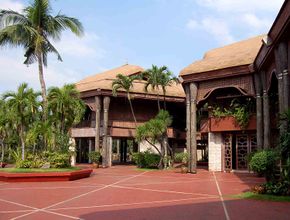
- Blue Wave Macapagal
- Heritage Hotel and Casino
- Marriott Hotel
- Remington Hotel
- Maxim's Hotel
- Hotel Sofitel
- Trader's Hotel
- The Hyatt Hotel
- Hotel H2O
- The Newport Residences
- HK Sun Plaza
- SM Mall of Asia
- Ninoy Aquino International Airport
- Members Church of God International Locale Church in Pasay
- CCP Complex
- Villamor Airbase
- Cuneta Astrodome
- Philippine International Convention Center
- Coconut Palace
- Bay City
- PAGCOR City (Underconstruction)
- Newport City
- Embassy of Japan.[2]
- Bible Baptist Church of Pasay [1]
- Golden Treasure Baptist Academy
- Star City
- Folk Arts Theater
- San Juan Nepomuceno Parish Church
- National Shrine of Jesus The Way, The Truth, and The Life
- Metro Manila World Trade Center
- Pasay City Market
- Boom na Boom
- Cartimar Shopping Center
- San Juan de Dios Educational Foundation, Inc. (Hospital)
Transportation
Rail
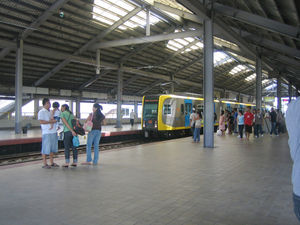
This city has 2 railways. The following railways are: LRT Yellow Line and MRT Blue Line. The depot of LRT 1 is located along Airport Road near Ninoy Aquino International Airport.
This city has 5 Railway Stations. The following are:
MRT 3: (with 1 Station)
- Taft Avenue (Interchange with Yellow Line)
LRT 1: (with 4 Stations)
- Gil Puyat
- Libertad
- EDSA (Interchange with Blue Line)
- Baclaran
Airport
This city is the location of Ninoy Aquino International Airport. These are the following NAIA Terminals:
- Terminal 1 (Old) - Ninoy Aquino Avenue
- Terminal 2 (Centennial) - NAIA Road
- Terminal 3 (New) - Near Villamor Air Base
- Domestic Terminal - Domestic Road
Road Network
Pasay City is accessed by these following major roads:
- Taft Avenue
- Roxas Boulevard
- Diosdado Macapagal Boulevard (Located in Reclamation Area)
- South Luzon Expressway
- Arnaiz Avenue (Former Pasay Road)
- Gil Puyat Avenue (C-3)
- Ninoy Aquino Avenue (Near Ninoy Aquino International Airport)
- Quirino Avenue
- Epifanio de los Santos Avenue (EDSA/C-4)
- Metro Manila Skyway
Etymology and early history
There are many conjectures as to the origin of the name Pasay.
In one version, the name of the municipality came from the wail of a brokenhearted swain. Jose and Paz were in love with each other and were intent on a life together, but Jose's father was a mere tenant of the hacienda of Paz's father. For this reason, their love was forbidden and Jose was ordered to stay away from Paz. Unable to bear her misfortune, Paz died.
At her funeral, the elite came to mourn and pray as Jose watched from a distance. As soon as everyone left, Jose dug a tunnel into the earth to be with Paz. Once joined, he let out a sharp and anguished cry "Paz-ay!" In sorrow and regret, the parents of Paz named their hacienda Paz-ay. In time, the town came to be known simply as Pasay.
Historians have another explanation for the origin of the name of the city. It is said that back in the day, Pasay was thick with pasaw, a plant with an exotic aroma. It was said that a Spanish botanist, Antonio Pineda, frequented a place called Basal in the vicinity of San Rafael to gather pasaw.
Pasay may also have come from the name of an ethnic group called Pasai in Malaysia.
The version deemed to be most credible is that Pasay was named after a princess of the Namayan Kingdom, Dayang-dayang Pasay. The Namayan Kingdom was a confederation of barangays that began to peak in 1175 and extended from Manila Bay to Laguna de Bay. Dayang-dayang Pasay inherited the lands now comprising the territories of Culi-culi, Pasay and Baclaran. The royal capital of the kingdom was built in Sapa, known today as Santa Ana.
The natives brought their products to the capital of Namayan. Trading flourished during the 12th to the 14th centuries. Merchants from China, Moluccas, Java, Borneo, Sumatra, India, Siam, and Cambodia came to trade with the natives.
Pasay's name may also have originated from the Spanish Paso hay meaning there is a pass. This referred to the paths cleared among the grass leading to the southern portions from Manila.
In 1727, the name of the Pasay settlement was changed to Pineda in honor of Don Cornelio Pineda, a Spanish horticulturist who requested for guardias civiles for protection from bandits. The name Pineda, along with Pasay, was used as the name of the place until the early 20th century.
History
Pasay was originally a barrio of maasim. Separation was granted on December 2, 1863.
Pasay became a city on June 21, 1947 with a population of 88,000 and was renamed Rizal City, after Jose Rizal, the country's national hero. In 1949, it was renamed back to Pasay.
On August 21, 1983, Sen. Benigno "Ninoy" Aquino, Jr. (the husband of former Philippine President Corazon Aquino) was assassinated in Manila International Airport (now Ninoy Aquino International Airport) during the Marcos Administration.
On May 21, 2006, SM Mall of Asia was opened in Bay City.
Pasay City's city anniversary is 2 December.
Government
City council (2010-2013)
| Position | Name |
|---|---|
| Mayor | Antonino G. Calixto |
| Vice Mayor | Marlon Pesebre |
| Congresswoman | Emi Calixto-Rubiano |
| 1st District | |
| Councilors | Mary Grace B. Santos |
| Richard M. Advincula | |
| Lexter N. Ibay | |
| Eduardo I. Advincula | |
| Albert C. Alvina | |
| Pinky Lyn I. Francisco | |
| 2nd District | |
| Councilors | Reynaldo Padua |
| Edita V. Vergel De Dios | |
| Reana N. Ibay | |
| Ian P. Vendivel | |
| Arvin G. Tolentino | |
| Bryan Kristiann P. Bayona | |
Important Offices Located at Pasay City
- Department of Foreign Affairs - Located at Roxas Boulevard
- Civil Aviation Authority of the Philippines - Located at NAIA Road
- Vice President of the Philippines - Located at PNB Headquarters along Roxas and Macapagal Boulevard
- Government Service Insurance System
- Senate of the Philippines
Economy
Philippine Airlines is headquartered in the Philippine National Bank Financial Center in Pasay City.[3] Spirit of Manila Airlines has its headquarters in Roxas Sea Front Garden in Pasay City.[4] Cebu Pacific and Interisland Airlines have their headquarters on the grounds of Ninoy Aquino International Airport and in Pasay City.[5][6]
Sister cities
 Jecheon, South Korea
Jecheon, South Korea Union City, California
Union City, California
References
- ↑ Municipality/City: PASAY CITY
- ↑ http://www.ph.emb-japan.go.jp/
- ↑ "About PAL." Philippine Airlines. Retrieved on May 19, 2009.
- ↑ "Contact Us." Spirit of Manila Airlines. Retrieved on September 13, 2010.
- ↑ "Call Center / Guest Services / Product Ideas." Cebu Pacific. Retrieved on March 31, 2010.
- ↑ "Contact Information." Interisland Airlines. Retrieved on August 11, 2010.
External links
- Official Website of Pasay City
- Star City Philippines Amusement and Theme Park in the Philippines
 |
Manila |  |
||
| Manila Bay | Makati Taguig |
|||
| Parañaque |
|
|||||||||||||||
|
|||||||||||
